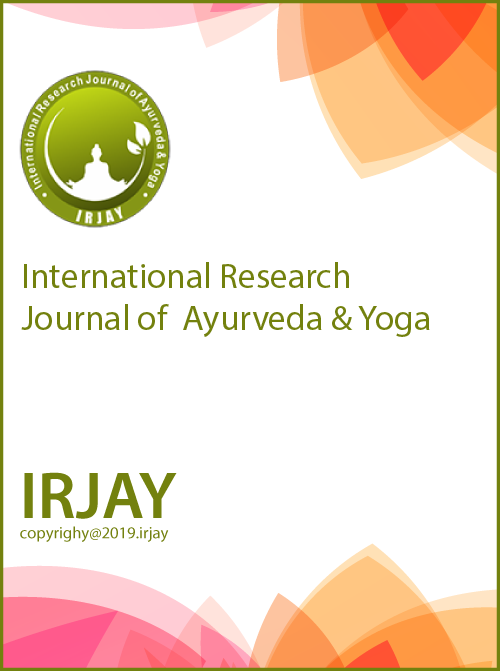Brahma Muhurta and Circadian Rhythms: A Gateway to Optimal Health
Keywords:
Brahma Muhurta, Dinacharya, Meditation, Ritucharya, Spiritual evolutionAbstract
Introduction: Ayurveda is a holistic science that improves the quality of life and provides curative measures for various disorders, thereby maintaining the health of millions of people. By following the rules of Dinacharya and Ritucharya, one can enhance their longevity. Dinacharya begins with Brahma Muhurta Jagarana. Brahma Muhurta is a specific time that recharges the biological clock in humans and maintains its rhythm and pattern throughout the day. Circadian rhythm is a biological process with an endogenous, entrainable oscillation of approximately 24 h. External factors, such as light and temperature, affect the circadian rhythm in humans. Objectives: To study Brahma Muhurta and circadian rhythm as a gateway to optimal health. Methodology: This research was conducted through a comprehensive review of research articles and classical Ayurveda texts, focusing on Brahma Muhurta and its correlation with the circadian rhythm. Results: A person’s lifestyle also affects this clock, resulting in undesirable traits and diseases. Brahma Muhurta is ideal for meditation and yogic practices, and one’s memory becomes sharp, leading them toward the ultimate goal of yoga, i.e., Moksha. Conclusion: Brahma Muhurta is essential for spiritual evolution, and a person who wakes up early in the morning slows down their aging process. This regimen supports the preservation of health and longevity in individuals free from illness.
Downloads
References
1. Datta A. Aṣṭāṅgahṛdayam. Varanasi: Chowkhamba Sanskrit Series Office; 1956. p. 24.
2. Sharma RK, Das VB, editors. Charaka samhita. Vol. 1., Ch. Su. 8/18. Varanasi: Chaukhamba Sanskrit Series; 2014. p. 17.
3. Tewari PV, Aṣṭāṅgahṛdaya, sutrasthana. Translator. Based on sarvanga sundari (arunadatta) and āyurveda rasāyana (Hemadri). Ch. 2. Varanasi: Chaukhamba Surbharati Prakashan; 2002.
30 Anuradha, et al.: Brahma Muhurta and circadian rhythms 2025; 8(6):27-31
4. Tewari PV, Aṣṭāṅga saṅgraha, sutrasthana. editor. Sarvanga sundari (arunadatta) and āyurveda rasāyana (hemadri). 2nd ed., Ch. 2., Ver. 1. Varanasi: Chaukhamba Sanskrit Series; 2002. p. 17-8.
5. Jyothi MG, Jyothi PB, Umapati CB, Pramod CB. A critical review on “Brahme muhurte uttishta swasthyo rakshartham ayushah”. J Ayurveda Hol Med (JAHM). 2014;2(6):55-9.
6. Gupta R, Shukla O, Shrivastava V, Acharya P. Adecent science behind the Brahma Muhūrta. Int J Ayu Herbal Med. 2017;7(6):3005-9. 7. Vagbhata. Aṣṭāṅga Saṅgraha, Sutrasthana. In: Tewari PV, editor.
Sarvanga sundari (arunadatta) and āyurveda rasāyana (hemadri). 2nd ed., Ch. 2. Varanasi: Chaukhamba Sanskrit Series; 2002. p. 17-8. 8. Sharma PV. editor. Sushruta Saṃhitā. Sutrasthana. 3rd ed., Vol. 1., Ch. 6. Varanasi: Chaukhamba Sanskrit Series; 2010.
9. Rātnākara Y. In: Tripathi I, Tripathi DS, editors. Nityapravṛtti prakar, dincharya. Ch. 3., 4th ed. Varanasi: Chaukhamba Krishnadas Academy; 2013. p. 45.
10. Kṛṣṇa L. Śrīmad bhāgavadgītā. 31st ed., Ch. 6. Gorakhpur: Geeta Press; 2002. p. 89.
11. Goswami D. Gargācārya. Garga saṃhitā, Balabhadra khanda. Balabhadra Khanda pt 8. 2nd ed., Ch. 10. Gorakhpur: Geeta Press; 2005. p. 152.
12. Tewari PV, Translator. Aṣṭāṅga saṅgraha, Sutrasthana. 2nd ed., Ch. 2. Varanasi: Chaukhamba Sanskrit Series; 2002. p. 16.
13. Tewari PV, Translator. Aṣṭāṅga saṅgraha, Sutrasthana. 2nd ed., Ch. 2. Varanasi: Chaukhamba Sanskrit Series; 2002. p. 16.
14. Glaser J. Body Renewal. 1st ed. New Delhi: Lotus Press; 2010. 15. Wikipedia Contributors. Suprachiasmatic nucleus. Wikimedia Foundation; 2019. Available from: https://en.wikipedia.org/wiki/ suprachiasmatic_nucleus [Last accessed on 2025 Feb 26]. 16. Sharma RK, Das VB, editors. Charaka samhita. Vol. 2., Ch. Vi 8/9. Varanasi: Chaukhamba Sanskrit Series; 2014. p. 220.
17. Kushwaha HS, editor. Charaka samhita - Ayurvedadīpikā (āyushī). Ch. Śh5a. 1/137. Varanasi: Chaukhamba Orientalia; 2011. p. 743. 18. Sharma RK, Das VB, editors. Charaka samhita. Vol. 2. Varanasi: Chaukhamba Orientalia; 2014. p. 39.


